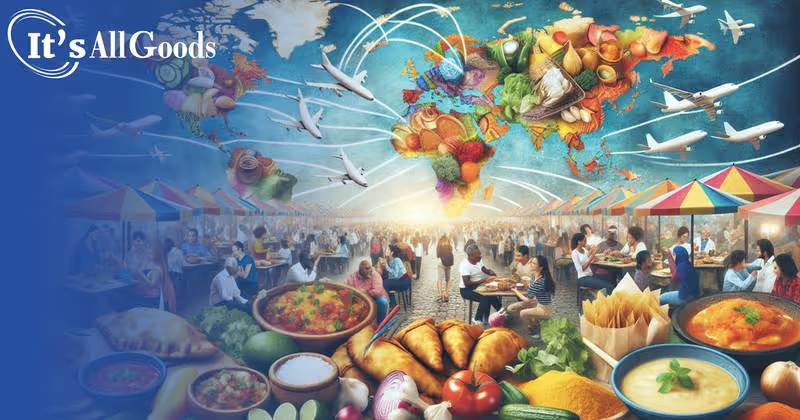

atin American cuisine, known for its rich blend of Amerindian, European, African, Asian, and Middle Eastern influences, has left a significant mark on the global food landscape, introducing vibrant flavors and diverse ingredients through dishes like quesadillas, tamales, and the Cuban sandwich. This culinary tradition has not only enriched the United States’ food culture with offerings such as Mofongo, Ropa Vieja, Arepas, Chupe de Res, and Salvadoran Pupusas but has also found resonance in Asia, where cultural connections and shared food preferences have propelled the popularity of Hispanic foods.
With the worldwide spread of Latin food, traditional Hispanic foods such as mole, empanadas, and seafood paella continue to gain international acclaim, underscoring the global impact of Hispanic cuisine. Chefs, restaurants, and businesses within this realm leverage core ingredients like corn, meat, beans, and rice, contributing to the evolving narrative of Hispanic culture food and offering a testament to the global appeal and influence of good Hispanic food.
Latin American cuisine is deeply intertwined with the region's cultural identity, where chefs are increasingly turning to local ingredients and traditional recipes to create culinary masterpieces. This resurgence of interest not only preserves heritage but also introduces the world to unique flavors and cooking methods that form the backbone of Hispanic culture food.
Innovative chefs and restaurants across Latin America are experimenting with new combinations of flavors while uncovering the health benefits of native species, including various plants and even insects, which offer unique nutritional benefits. This exploration is part of a broader movement towards sustainable and health-conscious eating within the region.
Food activism in Latin America plays a crucial role in promoting indigenous culinary practices and supporting local agriculture. This movement helps sustain local economies and ensures the preservation of culinary traditions that might otherwise be lost.
The globalization of Latin cuisines offers significant opportunities for the region's food industry. Ingredients like the Peruvian aji amarillo pepper and Mexican tequila are now in strong international demand, reflecting a growing global appetite for authentic Hispanic foods.
Hispanic cuisine is also known for its diverse range of traditional beverages, which include the red wine-based Sangria from Spain, the robust Tequila from Mexico, and the balanced Pisco Sour from Peru and Chile. These drinks not only complement the food but also enhance the overall dining experience with their unique flavors and cultural significance.
Non-alcoholic beverages like Horchata and Chicha Morada are integral to Hispanic dining, offering flavors that are deeply rooted in the culinary traditions of Spain and Peru, respectively. These beverages, made from local ingredients, are a testament to the region's rich culinary diversity.
The foundation of Latin American cuisine is built on staple ingredients such as corn, beans, rice, and a variety of meats, which are prominently featured across different dishes and regions. These core ingredients, combined with a rich array of herbs and spices like cilantro and chili peppers, define the vibrant and diverse flavors of Hispanic cuisine.
Indigenous cultures have significantly shaped Latin American cuisine, with many popular dishes and ingredients, such as maize and beans, originating from these communities. The advanced agricultural techniques of the Mayans, like nixtamalization, have particularly enhanced the nutritional value and flavor of these staple ingredients, making them central to Hispanic culinary practices today.
Latin American chefs are innovatively blending traditional dishes with global flavors, creating an exciting fusion cuisine that captivates food enthusiasts worldwide. This section highlights several modern interpretations of classic Hispanic dishes, illustrating the inventive spirit infusing today's culinary landscape.
These dishes exemplify how traditional Hispanic foods are being reimagined to meet the tastes of a global audience, maintaining their cultural essence while embracing new culinary trends.
Latin-inspired beverages continue to captivate the global market. In 2019, Coca-Cola led the beverage industry in Latin America with an impressive 2.6 billion Consumer Reach Points (CRP), generating a net operating revenue of 4.12 billion U.S. dollars. Pepsi followed as the second most popular, amassing 465 million CRP. The CRP metric is crucial as it measures the extent of a brand's interaction with its consumers.
The variety in Latin American beverages is vast. Concentrated beverages like "El gallito" offer a range of flavors including Agua de horchata, Agua de jamaica, and Agua de Tamarindo, highlighting traditional tastes. Jarritos, a renowned Mexican soft drink brand, is celebrated not only in Latin America but also internationally, offering an array of flavors. Inka Kola, a favorite in Peru, is known for its unique chewing gum flavor derived from lemon verbena.
Tropi Champan, originating from El Salvador, is distinguished by its fruity aroma and vibrant orange color, primarily made from the mamey fruit native to Central America and Mexico. Additionally, El Rancho Drinks provides a taste of the tropics with flavors like passion fruit, mango, pink guava, peach, and guanabana, further showcasing the rich diversity of beverages from Central and South America.
These trends and impacts underscore the dynamic nature of Latin American cuisine on the global stage, reflecting both the challenges and opportunities within the culinary industry.
Through a journey from traditional dishes to modern culinary innovations, Latin American cuisine has proven itself a formidable force on the global food scene. It has not only introduced a palette of vibrant flavors and diverse ingredients but also underscored the rich cultural tapestry that underpins Hispanic culinary traditions. The exploration of local ingredients, the renewal of interest in traditional recipes, and the embrace of sustainable and health-conscious eating illustrate the adaptability and enduring appeal of Latin American food culture.